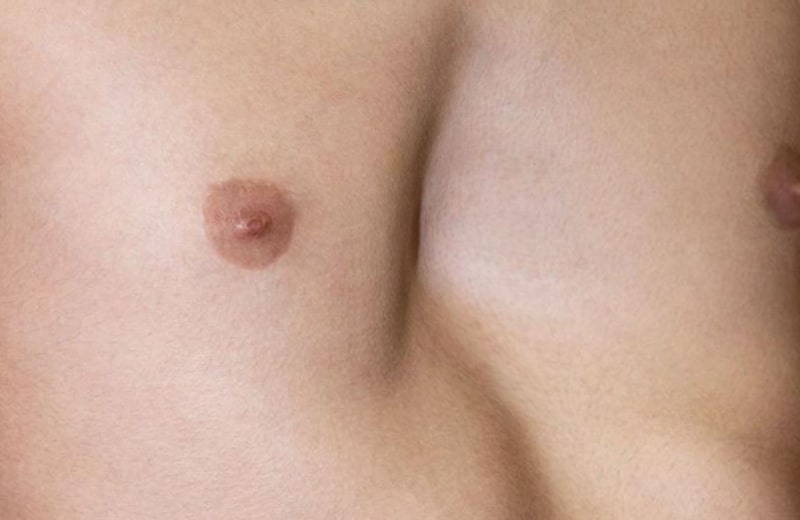1. What is the nature of the funnel chest condition?
Pectus excavatum in medical circles, or funnel chest, is a medical condition in which a depression is observed in the center of the chest, which can have different sizes. In this deformity, concave (more than usual) anterior parts of the rib cage as well as the ribs and a smaller size of the anterior chest are observed. It is typical for patients to have decreased productivity, experience pain and a feeling of pressure in the area of the deformity.
2. How does this condition affect the psyche of those affected?
Funnel chest affects the health and quality of life of those affected and can lead to psychological problems. The chest malformation represents a significant psychological burden, leading to lower self-esteem, which in turn can be a cause of reduced performance, self-isolation and depression. Young people often do not feel comfortable showing their upper body and therefore do not wish to go to the beach during the summer months.
3. What are the dangers of this condition?
It is important to note that the condition funnel chest does not disappear, on the contrary, with the growth of the child there are various amplifying consequences. These can be both functional and physical, with amplification being most significant during the years of puberty. It is for this reason that it should not be taken as a 'cosmetic problem' but should be addressed.
4. Are complications possible?
It may cause pressure on the heart. If such pressure occurs, the heart may not expand as much as necessary. As a result, it begins to shift more and more towards the left side of the chest. Thus, the heart loses its mobility and it carries less amount of blood with each of its pulsations. When practicing sports or any other type of physical exertion, the contracted heart has to increase its heartbeats in order to deliver the required amount of blood. The patient's endurance is lowered and he experiences a sensation of 'palpitations'. Young people tolerate the increased heart rate more easily than older people. A result of the indicated pressure on the heart and its displacement can be cardiac arrhythmia. The valves of the heart may not close completely and it is possible that this also has an effect on their function. The lungs, in turn, fail to expand fully, which can result in a reduction in their function by between 10 to 15%. This results in a lack of sufficient air during exercise, and may also be the cause of the development of infections in some cases.
5. How can the condition funnel chest be corrected and what methods are used at Wiener Privatklinik?
All patients with thoracic deformities are treated at the specialist centre for the treatment of thoracic deformities of the Wiener Privatklinik, including pectus excavatum. It offers patients state-of-the-art treatment, which includes both physically conservative methods and surgical procedures. The best results are achieved in children and adolescents.
In the conservative method of treatment, a special instrument is used, which is called a vacuum pump or "suction bell" and resembles a bell. Through it, the bulge is flattened and the flexibility of the chest is increased. It is recommended to use it every day for about two hours. Young patients, especially those starting at age 10, have the best results from treatment with this method. In practice, it is because of this that some patients can avoid surgical treatment. Research has confirmed the benefits for patients who benefit from this approach, which involves pre-treatment and subsequent surgery. Combining physical conservative therapy prior to surgery and subsequent surgical therapy has been found to produce positive patient outcomes and benefits.
6. At what age is it best to make the appropriate correction for this type of deformity?
Safe and effective correction of deformities in the breast area is a major concern for patients. The age factor plays an important role in this process. Usually, surgeries are performed around the age of 15. However, in some rare cases where serious deformities are encountered, surgical correction may be necessary at an earlier age, around 6 years. It is important to note that the possibility of breast correction in adulthood has limitations, usually up to the age of 50.
Biological age must also be taken into account. In patients with bony deformities of the ribs, as well as asymmetry of the chest at an older age, the process of surgical intervention is complicated. The insertion of plastic implants may offer aesthetic improvements, but this does not address the problem of pressure on the lungs and heart. In addition, patients are often not satisfied with the aesthetic result. Therefore, it is advisable to first perform chest shape correction. Only then to perform a breast augmentation procedure.
Currently, minimally invasive surgical procedures are performed through small lateral and medial openings. These procedures require the implantation of specially designed metal implants (1-2), which should not touch. Otherwise, the metal may wear away. Four years later, they can be removed. Implants with a multi-component design can lead to abrasion of the metal in the body. In these, the stabilising plates slip around the edges. To prevent such an event, it is recommended to use an implant with a built-in stabilization plate integrated on one side.
In patients who have a more rigid chest and are older, it is necessary to apply additional surgical measures. This may include excision of the sternum or rib cartilage. It may also involve the "rib arch correction" method, which I have modified and use in my practice.
7. What is the recovery process after the intervention for the correction of funnel chest?
For two months after implant placement, there are various restrictions in terms of physical exertion because the implant heals during this period. After this period, and after consultation with a specialist, it is possible to practise quite a few sports. It is also important to carry out physical exercises to strengthen the muscles of the trunk. For this purpose, patients can swim or go rowing, do gymnastics or hiking.





